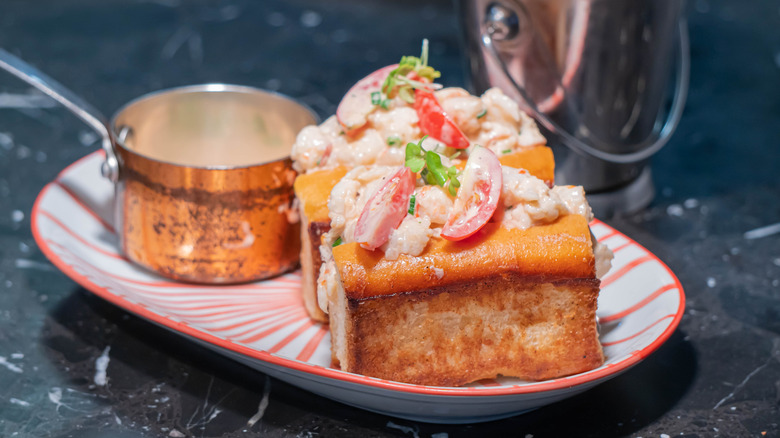The Unconventional Bread Martha Stewart Uses For Lobster Rolls
Lobster rolls are a quintessential New England treat and quite simple to make. All you need is some bread rolls, lobster meat, and a few condiments, such as mayonnaise, butter, lemons, and/or a few veggies, per Food Network. But depending on which part of New England you live in determines what style of lobster roll you may gravitate toward. In Maine, purists believe that chilled lobster meat is the way to go, which is often aided by mayonnaise, tarragon, and something crunchy, like scallions or celery. Connecticut locals beg to differ, though, as they usually favor warm lobster meat with a more straightforward approach, with nothing to hide behind aside from butter.
Although the lobster meat is the star of the show, the choice of bread that it's served upon makes or breaks the roll altogether. As Lobster Anywhere discusses, a top-split roll that's been grilled and flavored with melted butter is your best bet, and that's because of the softness of the bread in combination with how much butter soaks into it. If you can't find these types of rolls, you can always opt for croissants, hamburger buns, Italian bread, or Artisan bread, as Lobster Anywhere continues.
But there's another type of bread that makes for one heck of a lobster roll platter for parties, dinners, and snacks — and it comes from the genius of Martha Stewart.
Pack of dinner rolls
Dinner rolls are often seen as an accompaniment to a main course, be it for a holiday feast or a simple pot roast dinner. But Martha Stewart knows how to put these types of supporting players into the spotlight, namely, with her lobster roll recipe, which calls for 12 dinner rolls. The key here is to leave the rolls intact. That way, when you serve the lobster "dinner" rolls on a platter for guests, they can pull each one apart to make the meal more fun.
To start, you'll need to mix cooked lobster meat with mayonnaise, seasonings, lemon juice, and herbs. Next, slice the tops of the dinner rolls in a diagonal fashion and add some butter inside. Pop these in a 350-degree Fahrenheit oven for a maximum of five minutes, then remove them for the assembling phase. Now here's the fun part: Just stuff the lobster mixture into the warm dinner rolls and top 'em with melted butter and/or fresh chervil (for reference, chervil is basically French parsley that tastes mild with some hints of licorice and/or anise, per MasterClass).
Stewart doesn't mention whether the rolls should be cooked or uncooked or if frozen rolls work as well. But given the short time frame in the oven, it's probably safe to assume that the rolls should be cooked and not frozen. She also recommends Martin's or King's Hawaiian dinner rolls.

